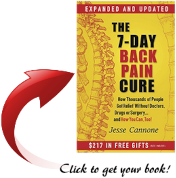On a previous blog post, I talked about the sciatic nerve and how certain conditions, such as lower back pain, could cause sciatica, which could then result in leg pain. Note, sciatica is a symptom and not a condition, and thus, it cannot be considered the cause of the pain. It is used to explain the symptoms of the sciatic nerve, which in general, is the irritation of the sciatic nerve. The pain originates from a nerve or a number of nerves located in the lower back, which is compressed or irritated by such conditions as spinal stenosis, herniated discs or lower back pain. And since the sciatic nerve runs from the lower back all the way to your toes, sciatic pain can be felt all along that nerve route. But it’s not doom and gloom if you experience pain from sciatica. There are a set of exercises listed on the site Spine-Health specially designed to help you get relief from sciatica pain! And that being said, here’s the article:

Sciatica Exercises for Sciatica Pain Relief
For most instances of sciatica pain, a specific, controlled, progressive exercise program that is tailored around the underlying cause of the sciatic pain will be part of the recommended treatment program. The specific sciatica exercises serve two main purposes:
-Reduces the sciatic pain in the near term
-Provides conditioning to help prevent future recurrences of the painA physical therapist, chiropractor, physiatrist (PM&R, or Physical Medicine & Rehabilitation physician), certified athletic trainer (ATC), or other spine specialist who treats the leg pain and other symptoms will typically prescribe specific exercises and teach the patient how to do them.
Exercise Provides Sciatica Pain Relief
While it may seem counterintuitive, exercise is usually better for relieving sciatic pain than bed rest. Patients may rest for a day or two after their sciatic pain flares up, but after that time period, inactivity will usually make the pain worse.
Without exercise and movement, the back muscles and spinal structures become deconditioned and less able to support the back. The deconditioning and weakening can lead to back injury and strain, which causes additional pain. In addition, active exercise is also important for the health of the spinal discs. Movement helps exchange nutrients and fluids within the discs to keep them healthy and prevent pressure on the sciatic nerve.”
Click the link to continue reading this article ===>>> Sciatica Exercises
The article from Spine-Health contained various exercises to provide relief from sciatica pain, focusing on specific locations or conditions:
- Herniated Disc
- Spinal Stenosis
- Sacroiliac (SI) Joint
- Piriformis Syndrome
- Isthmic Spondylolisthesis
- Degenerative Disc Disease
Here’s a video that demonstrates the Piriformis Stretch, and gives you a nice, simple explanation of what sciatica is:



